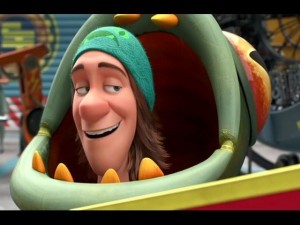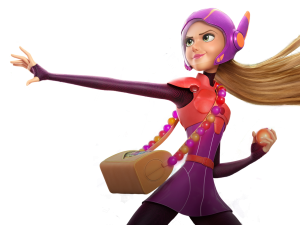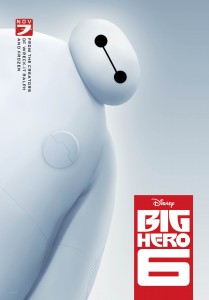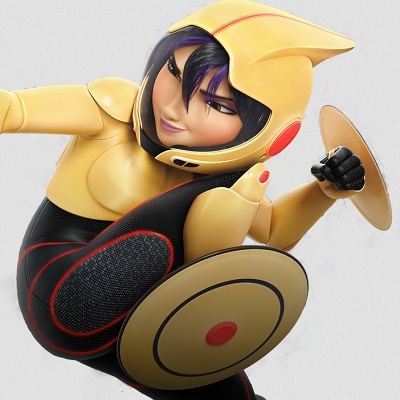Big Hero 6 (2014)
Written by Don Hall & Jordan Roberts
Directed by Don Hall & Chris Williams
Starring Scott Adsit, Ryan Potter, T.J. Miller
Walt Disney Studios/Marvel Entertainment
PG, 108 minutes
Disney and Marvel teamed up to bring Big Hero 6 to the screen. It is the first joint venture for the two companies since Disney acquired Marvel in 2009. It’s kind of an odd choice, really, given the huge and varied backlog of Marvel properties they had available. Big Hero 6 was a couple of miniseries in the 80s and 90s, full of problematic elements.
But, Disney doesn’t have their track record as the unstoppable (ahem) Juggernaut of animation for nothing. Even if they always turn the story they’re working with into their own variation on the original, making it essentially an alternate universe of the story they’re using. Big Hero 6 is no exception. It’s very much worth watching, and not for the reasons one might think.
SPOILER WARNING: There will be plot points revealed in this review.
The story is tightly and intricately woven — mostly. Disney made no secret that although Hiro (Potter) was the star, his older brother Tadashi (Daniel Henney) was not going to live for the events of the film. What they didn’t reveal is that the first forty minutes of the film sets up the two brothers and their relationship. Frozen was sisters, and the beginning of Big Hero 6 is brothers. Hiro is, at age 13, starting to go down the wrong path, because he’s graduated high school and is bored, but thinks Tadashi’s “nerd school” is too uncool for him to consider. Tadashi’s prize project, a cuddly inflatable robot called Baymax (Adsit) is written off by Hiro as hopelessly uncool. Tadashi is frustrated with Hiro’s hustling for money at the bot fights, but Hero is a genius in his own right. Tadashi recognizes that if the “stern talking to” approach doesn’t work, he needs to find a method that will.
Thus, Tadashi agrees to take Hiro to another bot fight — with a detour along the way to pick something up at Tadashi’s school. Here we meet Tadashi’s friends and lab partners: Wasabi (Damon Wayans, Jr.), Gogo (Jamie Chung), Honey (Genesis Rodriguez), and Fred (T.J. Miller) who is kind of their tagalong fanboy. Once Hiro gets a look at the lab, he finds himself fascinated by the projects Tadashi and company are working on. The game-maker, though, is when Tadashi’s teacher shows up: Robert Callaghan who is a famous roboticist and someone Hiro actually idolizes. Kudos all around for Disney making science look not just cool, but cool to a thirteen year old.
Once Hiro changes his mind, Tadashi is with him every step of the way as he works on a project for a tech show to impress Callaghan and get an invitation to study at the school. Once Hiro comes up with his project, the four friends from the lab step up to help as well — sadly portrayed as a montage of Hiro bouncing around with them at high speed. It would’ve been a good time for them to get some character development here.
Hiro’s project draws the attention he hoped it would. Tadashi and pals all head out to celebrate Hiro’s victory, but there’s a disaster. Tadashi goes to help — and never returns.
This is where the movie gets good by wrenching the viewer’s heartstrings by getting us to care about Tadashi and then removing him. Weeks after the funeral, Hiro is disconsolate. He isn’t eating, barely sleeping, and his acceptance letter to the school sits unopened. His aunt Cass (Maya Rudolph) gamely tries her best to nudge him along toward getting back to living again. But, a chance accident in his mess of a room results in a stubbed toe, causing Baymax to activate when Hiro cries out in pain.
This results in one of the funniest and most laudable moments of the film. Baymax, designed to be a medical assistant/companion/nurse, offers Hiro aid and treatment. Hiro wants nothing to do with the robot as he’s a reminder of Tadashi, but Baymax is determined to help. He realizes that Tadashi’s major problem is not physical but mental/emotional. He downloads an enormous database on mental health treatment then begins offering ways to help. Mental health is so often played for laughs or blown off in Hollywood treatments. But here, Baymax treats Hiro’s grief and depression as medical conditions requiring his attention and treatment. When Hiro declines his offers of assistance, Baymax, like Tadashi who programmed him, changes his approach; he begins asking questions. Mental health professionals and people who suffer from depression can tell you that that approach is often the better one.
As a result, we get a movie with a serious emotional core as Baymax focuses on trying to help Hiro feel better and deal with his rage once he finds out more about Tadashi’s death. The movie doesn’t shy away from boys showing emotion, either. Hiro’s grief over his brother’s loss is one of the most emotionally powerful moments in the film.

Unfortunately, this attention to Baymax and Hiro’s relationship and Hiro’s mental health results in a movie that should have been titled Hiro, Baymax, Those Other Three, and Fred. The rest of the team gets almost no character development at all.
Fred (Miller) is the weird and gross (the movie’s only potty humor comes from him, ewww) sign-spinning school mascot. He turns out to have more to him than that. He’s also a huge fanboy with an amazing collection of comics and memorabilia. Once he sees the masked villain chasing them, he decides the only way to help Hiro find out what’s going on with the villain is to become superheroes. He helps them suit up and practice.
We don’t even learn Wasabi, Gogo, and Honey’s real names. Fred nicknamed them. That’s how Tadashi introduced them. And that’s about all we get besides a look at their experiments which end up turning into their superhero gear. We get a flash of their personalities during the training montage. Gogo is tough; she has a little trouble with her gear, but refuses help until she gets it herself. Honey is kind of awkward, but doesn’t let it stop her. Wasabi is outright nervous and scared until he sees how cool his gear is in action — at which point he becomes more enthusiastic until the team starts acting without planning ahead.
Still, the trio do support the film’s emotional core; they offer Hiro their friendship and support, and they call him out when his teenage rage takes him to a dark place.
The animation of course is above reproach; it’s gorgeous. The storytelling has a couple of unexpected twists I didn’t see coming which is always a plus for me. Alan Tudyk has a voice role as well — and if he’s in a movie, you’re going to have to pay attention because things will not turn out as they appear at first.
The movie is also to be commended for its treatment of Baymax. He’s round, soft-edged, and cuddly because he was designed to be nonthreatening and huggably approachable. He is the focus of a couple fat jokes, but they’re not mean spirited; they’re actually built around the fact that Hiro is trying to use him for a purpose he was not intended and trying to force him quite literally into a hole he does not fit. In the end, Baymax is smart enough to work out his own way to support Hiro and still be true to himself and how Tadashi programmed him. But what this means is that the chubby character is portrayed as heroic and inspirational rather than ridicule-worthy. This is a huge step forward for representation of different body types, even if he is a robot, and I hope it starts a trend.
Disney also took quite a bit of care to pepper crowd scenes with people of different races. Since the movie takes place in a town that amalgamates Tokyo and San Francisco, there are a lot of Asians walking around in the streets. Even Krei industries has a significant amount of Asians in one of its branches.
The team also did work to animate a few different body types beyond “tall and thin, and if female, curvy.”
In the end, Hiro is saved from going further down his dark path by Baymax’s emotional intelligence (and Tadashi’s for having programmed that into him) and Tadashi’s method of inspiring people, adopted by his younger brother when the chips were down. This mirrors poignantly and beautifully with the motivation of the villain who is a lot more sympathetic than most.
But no film is perfect, and Big Hero 6 does have its share of problematic elements. Cass runs her own cafe out of a house in San Fransokyo and does the best she can while admittedly not knowing much about parenting. Honey and Gogo get few lines, though they each have small, significant moments with Hiro. Upshot: the only love story is a familial one between Cass and Hiro and between Hiro and the rest of his team.
In the original comic, the entire Big Hero 6 team were all Japanese. Disney attempted to do a “diversity” improvement on them — driven, I’m presuming, by the perniciously clingy Hollywood idea that no audience will want to see a movie of nothing but nonwhite heroes.
This results in Hiro and Tadashi being not Japanese, but half-Japanese, half-white. Wasabi has been made black, and thankfully he is not the jive-talking, street smart type; he actually is a little bit nervous about going into battle as a superhero, but acts mostly as the voice of reason. Gogo is now Korean, but falls victim to that “tough, scrappy Asian girl with a pink-or-purple streak in her hair” trope that is so often used in animation. Honey is Latina, but we know that from her accent more than anything else. She’s blonde and looks white.
Fred is a white guy. They tried to temper this by making him an unscientific nerd boy and the comic relief, but he gets a lot to do because of his background and his ability to help the team train. He also gets the “stay through the credits” scene for which Marvel movies are known.
 Honey, unfortunately, has been noted as one of the most problematic elements of the film since we started hearing about it. Disney “same girl syndrome” is strong in her. Her face looks little different from Rapunzel or Anna. Looking at her takes me right back to that “women are hard to animate” remark that overshadowed Frozen. Worse, Honey is the skinniest woman portrayed on screen — meant to make her look a little awkward, but succeeding mostly in making her look worryingly thin. Disney can do multiple body types as proven by Wasabi, Baymax, Hiro, and Tadashi, but when it comes to women, thin and thinner appears to be the only thing they can do.
Honey, unfortunately, has been noted as one of the most problematic elements of the film since we started hearing about it. Disney “same girl syndrome” is strong in her. Her face looks little different from Rapunzel or Anna. Looking at her takes me right back to that “women are hard to animate” remark that overshadowed Frozen. Worse, Honey is the skinniest woman portrayed on screen — meant to make her look a little awkward, but succeeding mostly in making her look worryingly thin. Disney can do multiple body types as proven by Wasabi, Baymax, Hiro, and Tadashi, but when it comes to women, thin and thinner appears to be the only thing they can do.
Still, the problematic elements are very small compared with the movie as a whole and are an indication that while they may not have it completely right, Disney is at least trying to do better with representation of the atypical and the marginalized. So, while it warranted mention because such problems must always be pointed out, in the end, Disney still gets my respect for continuing to move forward with diversity and representation, to say nothing of portraying science and intelligence as cool and positive traits!
3.75/5
Add that quarter star back if Fred’s gross-out moment doesn’t bother you. Remove it, if you found Fred’s fanboyishness irritating and stereotypical rather than endearing.
The star that keeps it from being 4.75 stars is due to the problematic elements and weak characterization for anyone outside of Hiro, Baymax, and Fred. If Wasabi, Gogo, and Honey had a little more background, giving viewers more reason to care about them, the movie would’ve been much better; the oversight stands out like a sore thumb in contrast with the emotional intelligence otherwise put on display. The other two white guys in the film had more to do than these three, even though these three were supposed to be primary protagonists.





